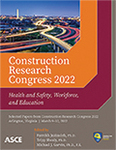Feasibility of Embodied Virtual Agents for Augmenting Students’ Knowledge of Robotic Safety in Construction
Publication: Construction Research Congress 2022
ABSTRACT
Robotic technologies have considerable potential to revolutionize the construction industry. This capacity has been mostly realized in the realm of human-robot collaboration wherein human dexterity and robotic precision allow the successful completion of tasks. Yet, these joint interactions demand knowledgeable and adept operators and engineers who have the necessary technical competencies to execute safe operations in the human-robot collaborative work environment. However, conventional learning systems (slides and videos) are not able to simulate the authentic complexities of practice. Therefore, this research aims to explore the feasibility of embodied virtual agents for augmenting students’ knowledge in safe practices of human-robot collaboration in construction. To that end, the study developed an immersive learning environment enhanced with a virtual agent to provide procedural instructions that can accompany the user throughout the learning experience. A self-assessment approach was leveraged among twelve students to compare the efficacy of students’ learning outcomes using the proposed learning system and the traditional learning systems (slides). Responses were statistically compared using the Wilcoxon-signed rank test. Results indicated a significant difference in the learning outcomes between the developed system and the traditional system. Findings demonstrated the potential of the simulated learning environment laden with the embodied virtual agents to enhance the students’ learning of robotic safety in construction.
Get full access to this article
View all available purchase options and get full access to this chapter.
REFERENCES
Afsari, K., Gupta, S., Afkhamiaghda, M., and Lu, Z. (2018). “Applications of Collaborative Industrial Robots in Building Construction.” 54th ASC Annual International Conference, 472–479.
Beer, J. M., Fisk, A. D., and Rogers, W. A. (2014). “Toward a Framework for Levels of Robot Autonomy in Human-Robot Interaction.” Journal of Human-Robot Interaction, Journal of Human-Robot Interaction, 3(2), 74.
Bock, T., and Linner, T. (2016). “Single-Task Construction Robots by Category.” Construction Robots, Cambridge University Press, 14–290.
Bunterm, T., Lee, K., Ng Lan Kong, J., Srikoon, S., Vangpoomyai, P., Rattanavongsa, J., and Rachahoon, G. (2014). “Do Different Levels of Inquiry Lead to Different Learning Outcomes? A comparison between guided and structured inquiry.” International Journal of Science Education, Routledge, 36(12), 1937–1959.
Dakhli, Z., and Lafhaj, Z. (2017). “Robotic mechanical design for brick-laying automation.” Cogent Engineering, Cogent OA, 4(1).
Dunleavy, M., and Dede, C. (2014). “Augmented reality teaching and learning.” Handbook of Research on Educational Communications and Technology: Fourth Edition, Springer New York, 735–745.
Eiris-Pereira, R., and Gheisari, M. (2018). “Building Intelligent Virtual Agents as Conversational Partners in Digital Construction Sites.” Construction Research Congress 2018: Construction Information Technology - Selected Papers from the Construction Research Congress 2018, American Society of Civil Engineers, 2018-April, 200–209.
Jarmon, L., Traphagan, T., Mayrath, M., and Trivedi, A. (2009). “Virtual world teaching, experiential learning, and assessment: An interdisciplinary communication course in Second Life.” Computers and Education, Pergamon, 53(1), 169–182.
Kavanagh, S., Kavanagh, S., Luxton-Reilly, A., Wuensche, B., and Plimmer, B. (2017). “A systematic review of Virtual Reality in education.” Themes in Science and Technology Education, 10(2), 85–119.
Kwon, C. (2019). “Verification of the possibility and effectiveness of experiential learning using HMD-based immersive VR technologies.” Virtual Reality, Springer London, 23(1), 101–118.
Le, Q. T., Pedro, A., and Park, C. S. (2015). “A Social Virtual Reality Based Construction Safety Education System for Experiential Learning.” Journal of Intelligent and Robotic Systems: Theory and Applications, Kluwer Academic Publishers, 79(3–4), 487–506.
Lester, J. C., Converse, S. A., Kahler, S. E., Barlow, S. T., Stone, B. A., and Bhogal, R. S. (1997). The persona effect. Association for Computing Machinery (ACM), 359–366.
Liu, Y., Habibnezhad, M., and Jebelli, H. (2021). “Brain-computer interface for hands-free teleoperation of construction robots.” Automation in Construction, Elsevier, 123, 103523.
Morato, C., Kaipa, K. N., Zhao, B., and Gupta, S. K. (2014). “Toward safe human robot collaboration by using multiple kinects based real-time human tracking.” Journal of Computing and Information Science in Engineering, American Society of Mechanical Engineers Digital Collection, 14(1).
Okpala, I., Nnaji, C., and Karakhan, A. A. (2020). “Utilizing Emerging Technologies for Construction Safety Risk Mitigation.” Practice Periodical on Structural Design and Construction, American Society of Civil Engineers (ASCE), 25(2), 04020002.
Qi, B., Razkenari, M., Costin, A., Kibert, C., and Fu, M. (2021). “A Systematic Review of Emerging Technologies in Industrialized Construction.” Journal of Building Engineering, Elsevier, 39, 102265.
Scott, L. M. (2016). “Theory and research in construction education: the case for pragmatism.” Construction Management and Economics, 34, 552–560.
Soliman, M., and Guetl, C. (2010). “Intelligent Pedagogical Agents in Immersive Virtual Learning Environments: A Review.” The 33rd International Convention MIPRO, 827–832.
Suci, A., and Martha, D. (2019). THE DESIGN AND IMPACT OF THE PEDAGOGICAL AGENT: A SYSTEMATIC LITERATURE REVIEW. Journal of Educators Online, Journal of Educators Online. 500 University Drive, Dothan, AL 36303. Web site: http://www.thejeo.com.
Sweet, R. (2018). “The contractor who invented a construction robot.” Construction Research and Innovation, Informa UK Limited, 9(1), 9–12.
Zimmerman, H. T., Land, S. M., and Jung, Y. J. (2016). “Using augmented reality to support children’s situational interest and science learning during context-sensitive informal mobile learning.” Advances in Intelligent Systems and Computing, Springer Verlag, 406, 101–119.
Information & Authors
Information
Published In
History
Published online: Mar 7, 2022
Authors
Metrics & Citations
Metrics
Citations
Download citation
If you have the appropriate software installed, you can download article citation data to the citation manager of your choice. Simply select your manager software from the list below and click Download.
